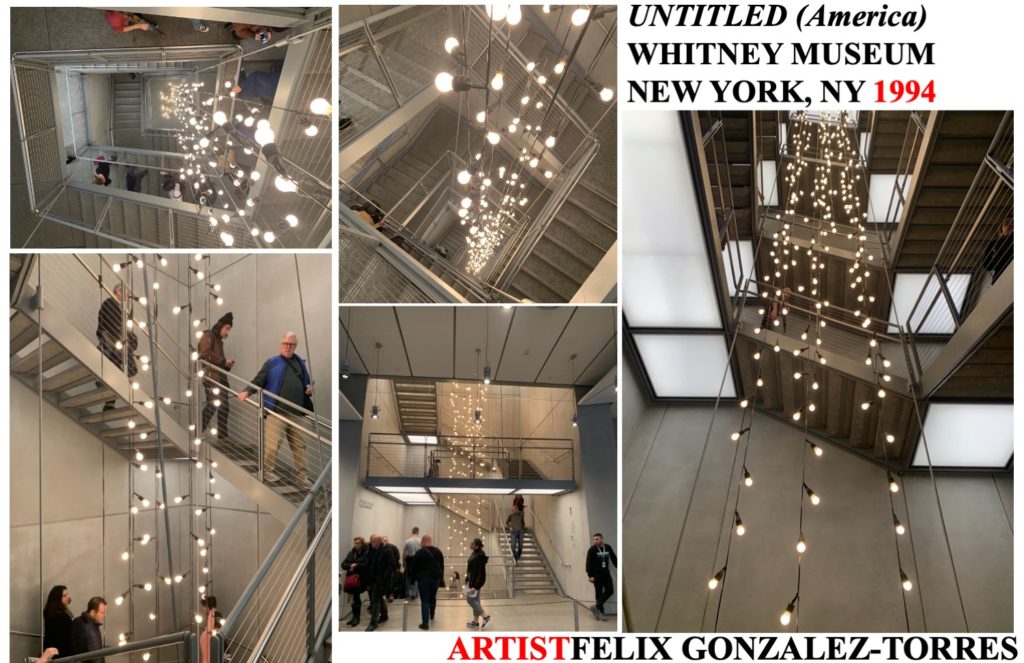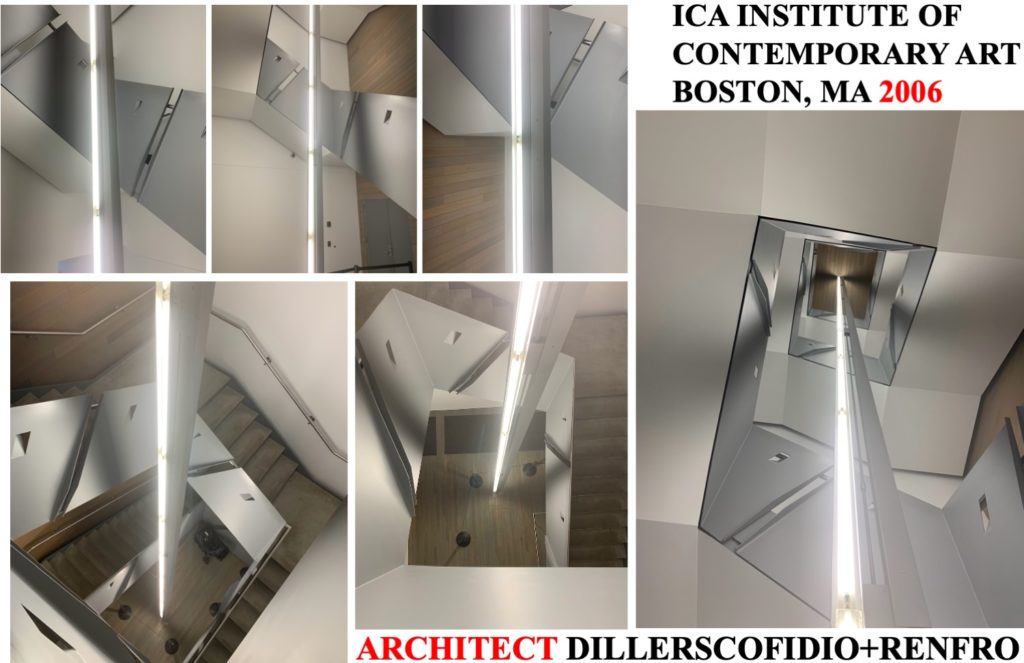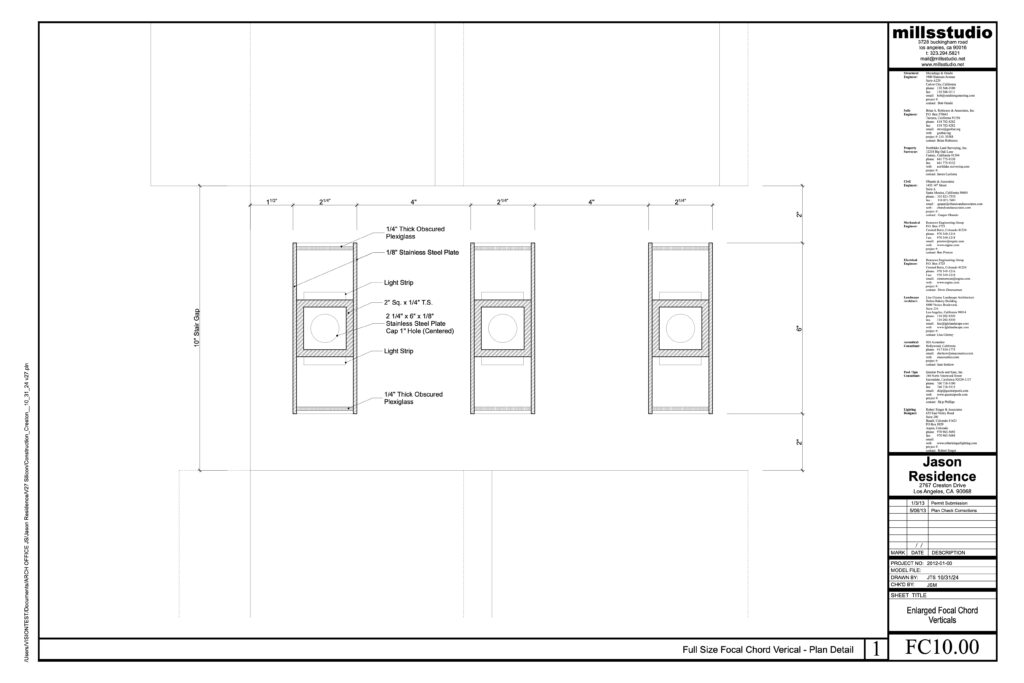Light is a powerful substance. We have a primal connection to it. But, for something so powerful, situations for its felt presence are fragile.
~ James Turrell
CENTRAL STAIR
ARCHITECTURAL LOCATION / CONTEXT
The Central Stair is a vertical spatial and visual element physically connecting the various horizontal levels of the DTS Project House. The Central Stair acts as the building’s connective tissue in both plan and elevation connecting the earthen hillside to the sky. The Central Stair provides for circulation but is also itself a space with varying degrees of enclosure at different levels and changing enclosure with the deployment of scrims at its perimeter on certain levels. The Central Stair is inwardly focused with no direct elevational views to the exterior. Peripheral glimpses of diagonal views are intended to create a dynamic circulation experience about up and down. During the daytime, the Central Stair is filled with natural light from its transparent glass skylight and at nighttime this reverses and interior artificial light escapes from the skylight.
The Central Stair provides the opportunity for a site-specific “artwork(s)” that addresses individual contexts of single levels or multiple levels or the staircase space itself; that accentuates or opposes the stair’s vertical nature and function; provides a presence from both distance and from close enough to touch. Maybe the most interesting opportunity the Central Stair offers to a site-specific installation is using the large-scale operable glass skylight at the top of the stair to make the piece “visible” from the wider community connecting The DTS Project House to Hollywood and Los Angeles. The Central Stair is literally about movement and thus an interactive site-specific piece could use acknowledgement and reaction to human presence as a generative force.

Two examples of staircase Site Specific installations, Untitled (America) by Felix Gonzalez-Torres and ICA by Diller Scofidio + Renfro.

The design of the Central Stair intentionally creates a narrow gap between stair runs at each level so that a vertical slot is created from the bottom concrete slab on grade to the skylight capping the stair volume. This almost fifty-foot-tall slot of space provides the opportunity for a site-specific installation to be experienced intimately on all five levels in addition to glimpses from various vantage points on and off the property. A site-specific installation emanating light might affect the atmosphere of various spaces and locations that have no direct visual connection to the piece.
The Main Level is where the Central Stair is the least permanently enclosed, but it still acts as the space divider organizing the public spaces. Its central location in both plan and elevation gives it several unique aspects that a site-specific artwork might address: its elevational location makes it impossible to see the top or bottom of a full height piece so that the installation could be made to appear floating with no beginning or ending; the differing configurations of scrims at the staircase’s perimeter dynamically change the character of the context for a site-specific installation at this level. The Main Level is a location where you could experience the Central Stair from a seated, more contemplative position.
“FOCAL CHORDS”
mills studio and the Owners engaged several light artists / fabricators / technologists to look at potential artistic / technological development of various locations in the DTS Project House, including the five story Central Stair. Illuminode of Los Angeles, with artist Mads Christensen among their team members, envisioned attaching continuous ground to roof LED light strips to the vertical stainless-steel cables in the narrow gap between stair runs and encasing the lights and cables with round white acrylic tubing. Illuminode labeled their vision for the Central Stair as “Focal Chords.” These initial thoughts of possibilities spurred mills studio and the Owners to think in further detail and more expansively about how to integrate functional and artistic intentions in a Central Stair art piece, and thought “Focal Chords” captured the appropriate notion of how the Central Stair should be developed as an art piece.
Based upon initial artistic considerations, it was determined that Focal Chords could and should first fulfill several lighting functions, would serve as the guardrail on one side of each stair run, and must account for and make use of the large retractable skylight in the roof of the Central Stair. These functional requirements would be achieved, not compromised, by making Focal Chords a project of artistic integration. Since the functional lighting aspects of Focal Chords is its development starting point, mills studio worked with the DTS Lighting Designer Robert Singer & Associates to use Focal Chords to fulfill the houses’ functional lighting requirements and then develop the Focal Chord conceptual and physical infrastructure necessary to integrate artistic intentions and content into the DTS Project House’s architectural, lighting, and technology design. Robert Singer used its experience designing and implementating large scale installations with content combining the art and science of light, such as the Stay Hotel in Times Square, New York City, to conceptualize a physical installation along with the infrastructure to program, operate, and control both light and content.
The Focal Chords design was developed sufficiently to produce a complete criteria of functional, technical, and artistic requirements sufficient to both implement the house design and allow members of the light artist community to propose a specific implementation and content. mills studio developed an informal RFP as a starting point for interested third parties to propose a work aligning with the developed criteria.
The art challenges the technology, and the technology inspires the art.
~ John LasseterFOCAL CHORDS DEVELOPMENT CRITERIA
Design / build proposals will be accepted for a functional light art piece to be installed in situ in the five-story central staircase of the DTS Project House currently under construction in the Hollywood Hills.
The scope of proposals should include the following as necessary to achieve the stated performance requirements:
- Specification, configuration, and installation of the necessary lighting components, including lighting “fixtures”, fixture covers, power supplies, and attachment hardware.
- Specification, configuration, and installation of necessary equipment hardware, cabling, and software necessary to program and control the installed lighting.
- Programming of software necessary to control and operate up to twenty established preset light sequences and random light sequences interfaced with motion and sound sensors.
- Propose for review up to three preset and or random light sequences deemed appropriate for the DTS Project House.
- Program up to three approved proposed light sequences and or video inputs.
- Consult with mills studio and low voltage sub-contractor to clarify and confirm technical requirements for proper interfacing with other relevant building systems installed and programmed by others.
- Test and commission entire installed system, including lighting, hardware, software, and interfaces with other building systems.
- Provide Owners with full hardcopy and digital copy of all component specifications, maintenance requirements, warranties, and program coding.
- Train Owners in control, operation, and program coding of art piece.
Performance Requirements
- RGB or RGBW Led Strips with individually programmable pixels to be installed on or within two sides of the provided 13-15 metal vertical structures approximately 47’ tall.
- Light installation to provide step lighting for safely using approximately 66 stair treads of Central Stair with no additional lighting required.
- Light installation to consider approximately 13’ x 6’ milky white glass skylight above installation in both closed and retracted position opening staircase to the sky, including installation of lighting emanating from top of metal verticals.
- Light installation to consider multiple experiences including direct up-close contact when touchable as guardrail; several feet away as on staircase both when scrims enclosing stair case are and are not present; and distances of 20-40 feet away when standing and seated.
- Light installation to consider ambient lighting effects on the various five levels with and without other house lighting on.
- Hardware, software, and programming to allow for video inputs as light sequences.
- Hardware, software, and programming to allow interface with Control 4 and KNX home automation installed by others.
- Programming to allow for control and operation of light installation with “Alexa” voice activation installed by others as part of Home Automation.
- Programming to allow for control and operation of light installation with “Basalte” Sentido wall switches and touch screens connected by others to KNX home automation.
- Programming to allow for interface with “Basalte” home automation application and enter presets and video inputs into scenes programmed by Owners.
- Hardware, software, and programming to allow for light sequences to be reactive to “Basalte” motion sensors installed by others.
- Hardware, software, and programming to allow for light sequences to be reactive to music inputs.
- Proposed light sequences and video inputs should accentuate the unique qualities and opportunities of the installation.
- Hardware, software, and programming to allow for up to twenty preset and video input sequences.
- Hardware, software, and programming to allow for the following stair presets, and allow for these presets to override all other presets and random sequences; allow for multiple of these presets to overlap for multiple stair users simultaneously; allow for these presets to remain on until purposely turned off or turn off after a designated time interval.
- Lower Level to Ground Level
- Main Level to Lower Level
- Upper Level to Main Level
- Intermediate Level to Upper Level
- Intermediate Level to Main Level
- Upper Level to Lower Level
- Hardware, software, and programming to allow for random light sequences responsive to motion sensors ad music inputs.
FOCAL CHORDS IMPLEMENTATION
Painters and sculptors, break through the barriers to architecture and become fellow builders, fellow strugglers for the final goal of art: the creative conception of the cathedral of the future, which will once again be all in one shape, architecture and sculpture and painting.
~ Walter Gropius


